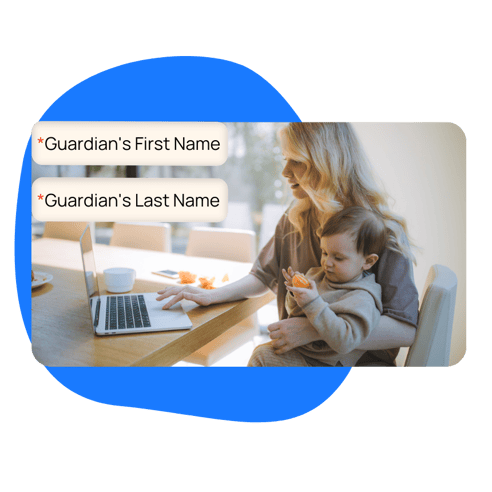Your daycare parent handbook is a business-critical resource. 📑
It gives families need-to-know info and prevents your team from getting weighed down with queries. Yet most childcare centers struggle to keep their handbooks up-to-date.
By taking just one day each year to check in and update your family handbook you can save countless hours in the long run.
Start with this simple parent handbook template to get the wheels turning. Just customize it with your center info and you’re good to go! 🍎👩💻
Table of Contents
Part 2: Drop-off and pick-up procedures
Daycare Parent Handbook Template: Key Tips and Tricks
But before you dive in, here are a few key tips to remember:
- Use simple language: This may be a family member’s first interaction with your center. Avoid jargon and technical terms.
- Make sure your procedures are up-to-date: If you’re struggling to keep policies and procedures updated, delegate each one to a member of your staff who knows the system.
- Decide how to share it: Gone are the days of heavy paper handbooks. Upload your new daycare parent handbook to your child experience platform to share key info at the click of a button.
1) Welcome! 👋🏻
Welcome to [childcare center name]!
This handbook includes everything you need to know about our facilities, how we care for our students, and what the [childcare center name] every day looks like.
Please read this handbook in full before your student’s first day and hang onto it for future reference.
[Include a section about your childcare center. For example, your mission aims, and why families have made the right choice to send their child into your care.]
Thanks for choosing [childcare center name] — we look forward to getting to know you and your family!
[name and signature]
2) About [childcare center name]
Here at [childcare center name], we believe [add your core mission].
[Include details about your teaching philosophy so parents know what and how their children can expect to learn. For example, do you focus more on academic skills or play-based learning? How do you approach learning opportunities and development benchmarks? What does your curriculum look like?]
Our aims:
- [Detail your center’s aims and how you plan to get there.]
- [What’s the goal of your curriculum?]
3) Important contact details and log-ins
Address:
Phone number(s):
Email address(es):
Website:
Childcare app(s) + log-ins:
4) Our calendar
Center opening hours:
Care schedules:
Dates for the diary:
[Include start and end dates, half days, term times and important dates like parent days or sports events. If possible, add a visual calendar screenshot or live calendar.]
Holiday policy:
5) Your daily schedule
Your daily schedule
Here’s how the day-to-day will run in your child’s class.
9am— Drop-off
9.15am — Play time
10am — Snacks
10.30am — Singalong
11am — Nap time
[Customize and continue based on how your classroom schedules run. Remember to include all meal times, nap times, outside play, drop off and pick up.]
6) Communication and working together
Keeping you informed of your child’s progress is top of our agenda. For us, it’s important that you know what’s going on in the classroom so you can be as involved as possible in your child’s care.
Here’s how we plan to communicate with you:
[Delete any that don’t apply and add any that do.]
- Keep you informed of your child’s progress with regular personalized updates via [text, email, letters, messaging apps, etc.]
- Give you access to our classroom video app, so you can check in on your child wherever you are.
- Post regular bulletins on the school messaging board to keep you up-to-date with classroom activities.
- Invite you to attend regular childcare activities and events, such as our weekly parent coffee mornings or sports events.
7) Drop-off and pick-up procedures
We love welcoming our students at the beginning of each day. But for families new to the program, drop-off can be a busy or even intimidating time.
To help you find your footing from day one and make sure everything runs smoothly, here’s how drop-off and pick-up work:
What to expect at drop-off:
What to expect at pick-up:
Late and early arrivals/departures:
How digital sign-in works:
Non-parental pick-ups:
8) Mealtimes
Keeping our students well-nourished is important. Here’s a bit about the types of meal plans we offer, plus a sample weekly menu.
[Include information on which (if any) meals you offer, what times they are, and some examples of meal types that children can expect.]
9) Supplies and snacks
We cover mealtimes and have plenty of supplies in the classroom, but there are a few things your child will need to bring to class.
Here’s what to bring:
[Include list of supplies. For example, snacks, diapers, painting clothes, etc. When it comes to snacks, point out any allergens that aren’t allowed in the classroom, and point parents to the Mealtimes section to let them know which meals you do cover].
10) Sick days
We hope you never need to use this section, but let’s face it — most kids get sick now and then. Here’s everything you need to know about sick days at our center.
How to know if a sick day is appropriate: Although parents know their child best, sometimes it can be hard to tell if a sick day is really needed. Here are a few tips and tricks to figure this one out:
- Check for allergens: Sometimes allergies can show up as colds. If you know your child has an allergy, check the environment for any allergens and wait to see if any other cold-like symptoms appear.
- Got a rash?: Not all rashes signal an illness, but it’s always worth getting unusual rashes checked by a doctor before bringing them in.
- Vomiting and diarrhea: If you know your child drank too much OJ or just ate too much fruit, it could be that this is the cause. Check your child’s temperature and wait to see if there is more than one incident before diagnosing the illness.
- Fever: A slight fever isn’t always something to worry about and, if the child seems otherwise fine, it’s ok to send them to childcare. If the temperature is above 38.5C/101.4F, it’s probably better to keep them at home and check in with a doctor if it persists or gets worse.
When to send your child back to school:
How to notify us of a sick day:
What if a child becomes sick at childcare?:
11) Other schedule interruptions
There are occasions when the daily schedule will be interrupted. Here’s how that works:
If you need to interrupt the daily schedule
Aside from sick days, there may be times when parents need to interrupt the daily childcare schedule (for example, if you are taking a family vacation or have a family emergency).
How to notify us of a schedule interruption:
When we need to know:
Does it affect your payments:
If we need to interrupt the daily schedule
Things like bad weather or flood warnings may also interrupt the daily schedule.
How we’ll notify you of a schedule interruption:
When we’ll let you know:
Does it affect your payments:
12) Behavior Policy
[Include your behavior policy here. What happens if a child misbehaves? What could cause immediate termination? How will you notify parents of any incidents? Include how you expect teachers to behave towards children, and vice versa, plus how disciplinary procedures work.]
13) Heath and Safety
The health and safety of our students and employees is extremely important to us.
Here’s our health and safety policy in full to reassure you that we always do everything possible to keep our community safe.
[Add your health and safety policy here. Include information on state regulations, child-to-staff ratios, outdoor playtime, certifications, accreditations, etc.]
14) Emergencies
We hope that this section won’t be needed, but to make sure our students and employees are safe, we need to be prepared for all emergencies.
Weather emergencies: [Add procedure]
Accidents: [Add procedure]
Medical emergencies: [Include info on how you’ll work with families of children with medical conditions to create an emergency plan.]
Emergency meeting points: [Include at least two meeting points in case the first one is too dangerous to gather at.]
Parent contact procedure: [Add procedure]
15) Fees and billing
Our pay structure:
When payments are due:
Late payments:
How to pay:
Variable charges you can expect to see:
How schedule interruptions affect billing and payments:
16) Enrollment, wait list, and withdrawal
You’re probably only reading this because you’ve already enrolled, but just in case you need a refresher, want to enroll another child, or have a friend who’s interested, here’s the lowdown on how to register your child with us.
Program costs:
Eligibility requirements:
Wait list info: [Do families with enrolled children get preference for other children? Are there any early-enrollment options? When will families on the waitlist hear back?]
How to withdraw: For a variety of reasons there are times that families need to withdraw their child from our program, and that’s okay. Here’s how to do it:
- [Add bullet points explaining how parents can notify you, how far in advance is best, whether families will be penalized for withdrawing a child early, etc.]
17) Forms to return
Here’s what we need from you before your child’s first day:
[Include a checklist of any childcare forms to be returned before the session starts. You can add any relevant forms at the end of the parent handbook to make it even easier for them to remember.]

LineLeader: Digital childcare forms for registration
18) Acknowledgment and signature
Here’s the dotted line. By signing below you agree that you’ve read and understood this handbook and that you’re happy to abide by our policies and procedures.
Parent name:
Child name:
Parent signature:
Date:
And that's a wrap. Now you have an expert daycare parent handbook template to customize to your center's needs. Remember - make it easy for parents to get involved with their child's education by providing:
- an excellent childcare experience
- clear policies
- digital options for consistent communication
Still Didn't Grab Your Free Template?
No worries! We've got you covered.
Download your FREE daycare parent handbook template by clicking the download button below! 🏫
Not a User Yet or Interested in Adding More Products?
Schedule a FREE demo to see how LineLeader can help streamline operations. Digitize your center to save valuable time. 😌



.png?width=352&name=featured%20images%20(1).png)
.png?width=352&name=Copy%20of%20Featured%20Blog%20Photo%20Templates%20(61).png)
